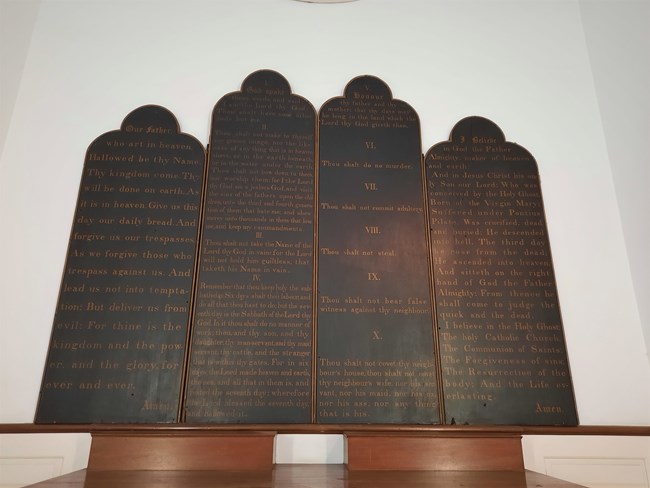Last updated: January 11, 2022
Article
Wooden Tablets from the 1840s reflect Important Changes at St. Paul's

National Park Service
Wooden Tablets from 1840s Reflect Important Changes at St. Paul’s
Inscribed with gold leaf lettering, four dark wooden tablets on the eastern wall o fSt. Paul’s Church symbolize an important chapter in the religious evolution of the church, especially its mid-19th Century confirmation as an Episcopal parish.
Rectangular, with tri-partite tops, the tall sanded oak boards reveal elements of the Word, received wisdom through divine inspiration, as accepted by most Protestants. They are the Lord’s Prayer and the Ten Commandments, drawn from the Bible, and the Apostle’s Creed, an early statement of Christian faith believed to date to the 5th Century. While they were installed at St. Paul’s in 1848, more than 160 years ago, the tablets’ arrival came relatively late for an Episcopal church.
The reasons for this delay are rooted in St. Paul’s origins as a dissenting parish in the17th Century. The community’s founders were Puritans, favoring Presbyterian ministers, which meant they were not members of (or were dissenters from) the Church of England. In a fundamental understanding of religious expression, they recoiled at ornamentation as idolatrous and reminiscent of the Catholic Church, a distinction originating in the Protestant Reformation of the 1500s. The tablets, which were common in English Anglican churches by the early 1700s and even in many Church or England sanctuaries in colonial America, were the type of adornment they avoided.
The Church of England was established as the official religion in lower Westchester County, New York, in the early 1700s, overriding the community’s traditions as dissenters, although attachments to existing customs remained strong. Through the Revolution, Anglican ministers assigned to the parish faced opposition to introduction of the more ceremonial side of the Church of England worship, exemplified by Rev. Samuel Seabury’s difficulties in persuading parishioners to participate in the Eucharist in the 1760s and 1770s. Ornamentation, such as the tablets expressing the Word, was still not welcome by the congregation.
Following the Revolution and the creation of the Episcopal parish of St. Paul’s, the congregants’ dissenting religious preferences remained dominant in the extant stone and brick church. While the parish extended resources to construct the necessary components of the church interior -- the gallery, high walled box pews, pulpit -- the setting remained sparse.
So what happened?
Gradually, perhaps inexorably, St. Paul’s developed into an Episcopal parish, and objection to enhancement dwindled. The worshippers of the 1840s bore little resemblance to the dissenters who founded the parish, and embellishments such as the tablets were now acceptable. As a regular parish within the diocese of New York, St. Paul’s was expected to display the religious messages inscribed in the tablets, and in the development of the church, plain wooden boards were no longer seen as idolatrous. Additionally, it’s likely the bare white walls of the sanctuary, lacking religious symbolism, failed to satisfy the spiritual expectations of the congregants. The church was a special place, not simply a meetinghouse, and some visual expression of that sentiment was warranted.
Further, the wooden boards with the Word provided an avenue of giving for a wealthy family who decided the time had come for St. Paul’s to display these religious symbols, although their acceptance by the vestry and the rector indicates general approval. They were gifted by Emily Prime Seton, who lived about a mile from the church, representing a family prominent in the affairs of the town and the parish. (Her husband William Seton, deceased by then, was the oldest son of Elizabeth Ann Seton, who converted to Catholicism after the death of her husband in 1803, taking vows as a nun and establishing the American Sisters of Charity, the country’s first Roman Catholic religious order. Canonized in the 20th Century, Elizabeth Seton was the first American-born saint.)
A fine piece of craftsmanship, the hand applied gold leaf inscriptions illuminating the black tablets reflect the painstaking attention of a skilled calligrapher. Twenty four carat gold leaf was carefully sprinkled over an adhesive, often called size, which had been meticulously applied to the painted wood in the letter form, culminating with light burnishing using cloth or cotton. Sketched to correspond with available space, the two boards enshrined with the Commandments are 2’ x 7’, while the tablets with the Lord’s Prayer and the Apostle’s creed are slightly wider, 27”, but shorter, at 6’, with larger lettering. The board’s shapes are inspired by the perception of the stone tablets inscribed with the commandments given to Moses, according to the Old Testament.
Reflecting physical changes in the sanctuary, the plaques have been moved several times over the course of 160 years. Initially fastened in a large eastern window, they were shifted to the walls on either side of the chancel in the 1850s following the addition of a new wing of the church eliminated that window. After the 1942 restoration of the interior to its original 1787 orientation with the pulpit on the south wall, the four oaks were moved again, and by the last service in the 1970s, they had been transferred to their current location, on a wall at the eastern end of the church. Today’s visitors to St. Paul’s Church N.H.S. observe them there, but still in their original appearance, as viewed by Civil War soldiers on leave and Franklin Roosevelt, among others.
